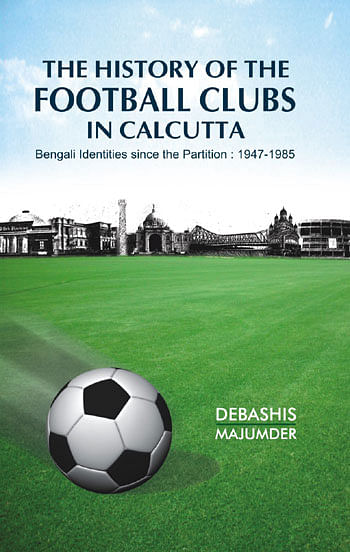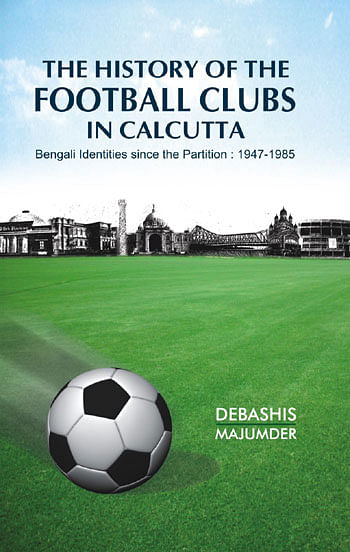
Book Review: The History of the Football Clubs in Calcutta

The History of the Football Clubs in Calcutta (1947—1985); Bengali Identities Since Partition
By Debashis Majumder, Readers Service, Kolkata, September 2012, Price Rs. 250.
In his thought-provoking and well-researched slim book, young scholar Debashish Mazumdar aptly shows how the colonial period football has played a very significant role in the political and cultural field of Bengali society. The origins and development of the great “Ghoti-Bangaal” (Mohun Bagan and East Bengal) rivalry are meticulously traced and commented upon. Debashis has used newspaper reports as his primary source of information along with field surveys and interviews.
The book is neatly divided into six chapters and presents a chronological view of Calcutta football before partition, till 1980s. The author is to be complimented for his attention to detail and rich nuggets of information which embellish the book. For instance, he says that Mohun Bagan defender Gostho Pal in the 1920s became a nationalist symbol on the football field, not because he won any major tournaments but because his powerful tackles against the British players destroyed the myth of physical weakness of the Bengalis.
The author also shows that Jyotish Guha, who took over East Bengal in 1940, rebuilt his side by recruiting from all over India, a trend set by the successful Mohammedan Sporting Club in the 1930s. Constituting East Bengal’s legendary forward line, from 1949—53 – P. Venkatesh, Appa Rao, Dhanraj, Ahmed Khan and PBA Saleh were all from either Hyderabad or Bangalore. In contrast, Mohun Bagan, during this period, recruited talented players only from Bengal. The author reveals that due to their historic 1911 IFA Shield victory, Mohun Bagan had a national identity and so captains of Indian teams for the 1948, 1952 and 1956 Olympics were always chosen from this club.
Debashis describes how in the post-independence period, the footballing identities of the Calcutta clubs changed. Mohun Bagan was transformed from a nationalist symbol to a symbol of aristocracy for the traditional families of West Bengal. The refugee crisis which affected the socio-political and economic atmosphere of West Bengal, reflected on the football field. The 16 lakh refugees from the eastern region of Bengal mostly settled in Calcutta and got emotionally attached to the East Bengal club. For the refugees staying in tents or hastily constructed re-settlement colonies, the success and failure of East Bengal became their own failures and successes in daily life. Urban society in Calcutta thus got polarized and feelings of a type of class struggle also prevailed in the traditional Mohun Bagan-East Bengal clash.
Debashish traces the timeline of this historic rivalry by quoting senior sports journalist Rupak Saha.
According to Saha, the influx of refugees in the 1950s, and identity with East Bengal led to a major craze for the match against Mohun Bagan. So from the 1950s, this match became the clash of the titans, which also acquired a socio-cultural ethos. The derby match was first a major craze within the city of Calcutta. However, the impact of live running commentary on All India Radio made the East Bengal vs Mohun Bagan clash a passion for people all over Bengal.
The book shows the decline of Mohammedan Sporting after partition, as it lost a huge section of Muslim supporters who migrated to Pakistan. The catchment area for the club also declined as they only recruited Muslim players. This rigid religious attitude caused a downfall in the performances of the club and by the mid-1950s, Mohammedan Sporting officials withdrew this rule and recruited non-Muslim players. This policy helped and in the 1960s, Mohammedan Sporting won the DCM tournament twice, in 1961 and 1964 and the Calcutta league in 1967, but could not match the financial clout of Bagan and East Bengal. Thus, Mohammedan Sporting became the third biggest power of Calcutta football.
The author shows that due to their wealth, clubs like Mohun Bagan and East Bengal made Calcutta the main centre of Indian football. For both financial reasons and prestige, the best players in the country in the late fifties and sixties, like Peter Thangaraj. T. Balaram, Jarnail Singh, Kempiah, Ram Bahadur, Syed Nayeemuddin, Mohammed Habib, Shyam Thapa and others, all played in Calcutta and became popular with the fans.
Cinema, player transfers and attitudes of supporters are all skilfully woven into a major narrative to show the intense rivalry between East Bengal and Mohun Bagan. Famous film director Satyajit Ray, in his film Jana Aranya, showed how club identity turned into social prestige for a man in the 1970s. A man gets questioned about his academic qualification but his replies reflect his club identity (namely Mohun Bagan). So football was not just the inspiration, but a way of life for the fans. An example of the fanatical following is shown in the life of Baghada, an East Bengal fan of the 1970s who came to the ground to cheer for his team in every match, even on the day of his son’s death.
Disgruntled fans often indulged in violence if their team was humiliated, like when Mohun Bagan lost 0-5 to East Bengal on 30 September, 1975 in the IFA Shield final. Bagan players like Bhaskar Ganguly, Subrata Bhattacharya and Prasun Banerjee went into hiding to escape the wrath of their bitter fans. They were rescued by club legend Sailen Manna with the help of the Calcutta police after midnight. Player transfers also became full of subterfuge and intrigue and some players were even kidnapped to get signed for a particular club. The rise of vernacular sports journalism, increase in number of Bengali newspapers and separate columns on football made the players heroes among the youth. All these factors, to a large extent, increased the tension of the derby matches in the 1960s and 70s.
It is hard to believe, but this book aptly shows that in the 1960s and 70s, there were better career and financial opportunities for a football player in Calcutta than for a cricketer. The book ends with the description of the death of sixteen football fans at the Eden gardens during an East Bengal vs Mohun Bagan match on 16 August 1980. Fights erupted in the stands after Bidesh Bose of Bagan, and Dilip Palit of East Bengal clashed on the ground and were shown the red card by referee Sudhin Chaterjee. The author shows that mismanagement by the West Bengal Government’s Ministry of Sports and failure by the police to control the situation led to the disaster. The seating arrangements were pathetic and there was no divisional barrier between Bagan and East Bengal supporters.
The book ends on a sombre note, with the author quoting Rupak Saha again and stating that this particular event created panic among the Bengali middle class and they started moving away from football and stopped watching derby matches in the stadium.
For anybody interested in Indian and Asian football’s biggest club rivalry, this book – with its fast flowing narrative – is essential reading. To understand the causes of violence and stone throwing in the recent East Bengal vs Mohun Bagan match, in which international Syed Rahim Nabi got injured, Debashis’ book will provide an excellent historical perspective.